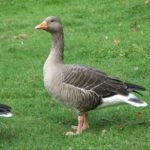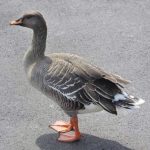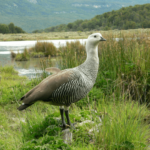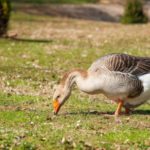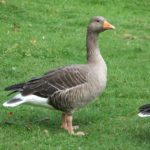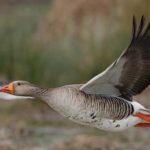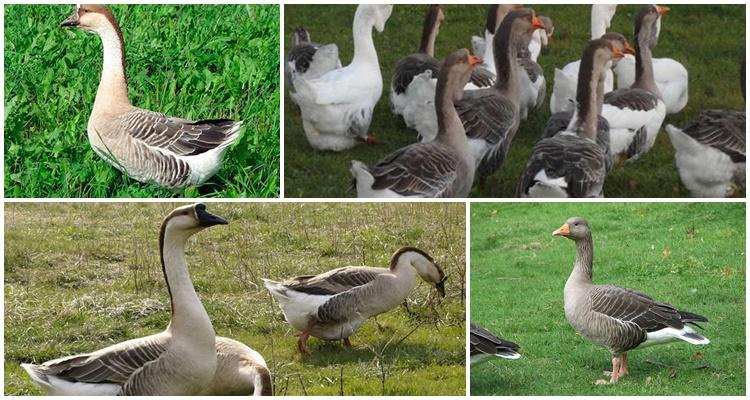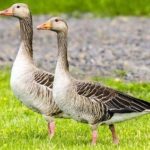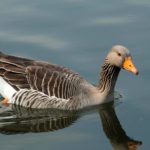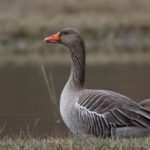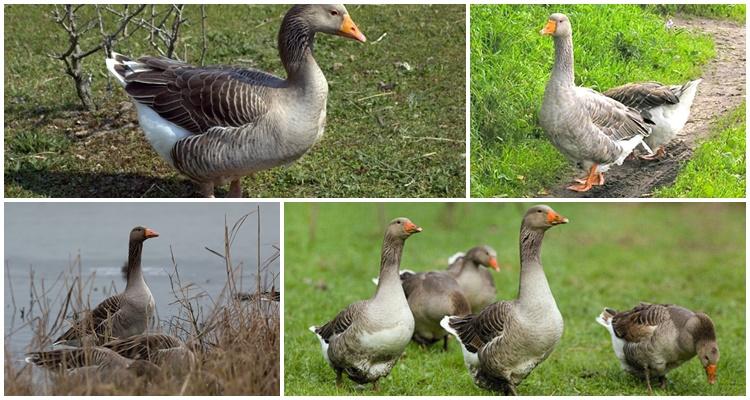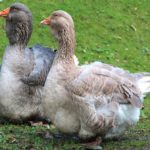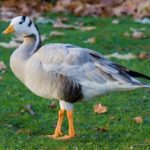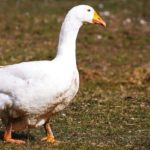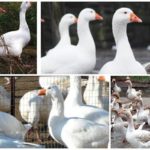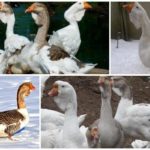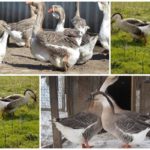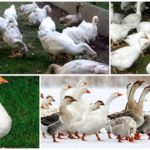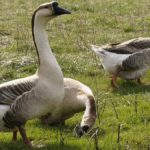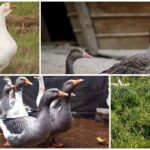The gray goose is a large meat-producing breed of poultry, which is distinguished by its average egg production and valuable down. Most often it is found in private backyards. The gray breed includes several varieties of geese, which are bred for personal needs and for the sale of meat products. The birds are unpretentious in their care, do without a pond and love to spend the summer on pasture.
History of breeding
Gray geese are bred using selective breeding.Scientists set the task of obtaining a new type of poultry, adapted to warm and cold climates. The Romny and Toulouse breeds were used in crossing. Ukrainian scientists from the economic complex in the village of Borki, Kharkov region, began to develop a new variety. As a result, the Borkovsky or Ukrainian breed of the same name appeared.
During the Great Patriotic War, farm employees had to evacuate. Work continued on the farm in the Tambov region. Scientists managed to improve the qualities of the breed bred in Borki. The exterior of the birds was almost the same. But the variety of geese was still identified separately under the name Tambov.
General description and characteristics of large gray geese
External signs common to the Tambov and Ukrainian goose:
- broad-chested, with developed muscles;
- strong wings that fit tightly to the body;
- head size is proportional to body size;
- eyes are outlined in orange;
- orange beak with pink tip;
- neck of medium length;
- the color contains various shades of gray;
- the wings are marked with a wavy, pockmarked pattern;
- paws are orange.
The giant gray goose differs from other breeds in the absence of a bump above the beak and a “purse” under the beak. Geese fly well, so their wings are clipped. Females are smaller than males. They have a shorter neck. There is a hierarchy in the pack. Gray geese are sociable and loud. Birds use their voice to warn their relatives about danger.
The normal weight of an adult goose is 5-6 kilograms, a fattened one is more than nine kilograms. Geese do not gain more than seven kilograms and produce 40-60 eggs per year. The egg weighs 160-180 grams. The survival rate of goslings is 65 percent. During the period from hatching to two months, the chick becomes heavier by 5 kilograms.Three-month-old goslings look like adult birds and are ready for slaughter at 9 months. The young molt once every six months. Adult geese renew their plumage once a year.
Breed varieties
The Borkovsky goose is also known as the Kharkov goose. Differences between the main greylag goose species relate to climate tolerance and diet composition.
The Ukrainian goose is most adapted to warm climates and needs year-round feeding with plants more than others. The Tambov variety is suitable for a temperate climate and a diet of grain crops. Other domestic breeds:
- Kuban goose - distinguished by a longitudinal black stripe on the back, from head to tail, is inferior in weight to the Borkov and Tambov species, in an adult carcass - 5 kilograms, more resistant to frost and dampness, has strong immunity;
- Shadrinsky (Ural) goose - known since the 17th century, it appeared as a result of crossing wild and local poultry, looks like the Tambov goose, but is also white in color;
- Mirgorodsky goose - used in the improvement of other breeds, is characterized by low egg production, the female produces 15 eggs per year, the advantage compared to the Kuban goose is 400 grams.
The species are colloquially grouped under the common name cardinal gray.
Main pros and cons
Geese of the gray breed are inferior in egg production to breeds of the egg breed, but in the meat-fat group they show high productivity.Goose down is used to insulate outerwear, stuff pillows and blankets.
Geese should not be left in the sun in summer. Birds quickly get sunstroke and get sick from a slight draft.
Maintenance and care
The main requirement for a poultry house is dryness and warmth. The gooseneck is assembled from brick or wooden planks, insulated and the cracks are sealed. The floor is placed on an elevation, forty centimeters above the ground, so that dampness does not penetrate through the flooring.
In winter, the floor is covered with a layer of peat or straw. The bedding is changed every 3 days. Over the winter, 40 kilograms of litter are consumed in a poultry house with adult birds, and 8 kilograms with goslings. In the spring, used gossamer bedding is used as fertilizer. In summer, fine sand or gravel is poured onto the floor of the poultry house.
Other requirements for keeping gray geese:
- natural and artificial lighting;
- temperature +20 degrees;
- hanging feeders;
- automatic drinkers.
Nests are set up for geese - before laying eggs, cardboard boxes with straw at the bottom are placed in the house.
Diet
Feed is selected taking into account the purpose of breeding geese. For fattening, birds are given more grain with protein - barley and oats. To prevent vitamin deficiency and normal digestion, geese require fresh field grass, alfalfa, and hay. For the development of bones in chicks and the formation of eggshells in laying hens, low-fat cottage cheese, flour from fish and beef bones, chalk and salt are given.
Gray goslings up to four months of age require a special approach to feeding:
- 1st-3rd day - chopped boiled egg and corn kernels mixed in cottage cheese;
- 4th-7th day - boiled chopped potatoes, carrots, cake;
- 2nd-4th week of life - legumes, bran and mineral supplements are introduced;
- 5th-8th week - crushed barley, oats and wheat, bone meal are added;
- 3rd-4th month - bone meal is removed from the diet.
From the sixth month, the young animals are given more peas. The food is diluted with a small amount of water to the consistency of porridge. When fattening, there are 8-12 kilograms of feed per kilogram of weight, most of which is succulent feed.
Birds become adults at nine months. Their diet does not change significantly. In summer, geese forage for plant food in the pasture. For the winter, hay, root crops, as well as alder and birch branches with leaves are prepared for them. The twigs are hung in a goose barn, and the chopped leaves are added to food.
Bird breeding
Gray geese become sexually mature at 8-10 months. The mating season occurs in February and March. In the wild, males are monogamous. On private farms there is one goose for every two or three geese. From March to April, females incubate eggs. During hatching, additional lighting is required in the evening so that the hens have 15 hours of daylight. The temperature in the poultry house should not fall below nineteen degrees Celsius. Therefore, in a long cold spring, you will need to heat the room with a heater.
Products with calcium - cottage cheese, yogurt - are added to the brood hens' diet. Ready-made nutritional supplements are also provided. Otherwise, due to a lack of substance, the geese will peck at the shells of the eggs. The hens are fed 3 times a day, taking turns calling them to the feeder.
The peak of fertility in gray geese occurs in the third or fourth year of life.Geese lay eggs every two days. New eggs are transferred to an incubator and kept cool. To hatch chicks, 15-17 eggs are left, which are laid on the hen at the same time. Gray geese carefully look after their offspring, and geese protect them. It is not recommended to take chicks from their parents. Birds become restless.
Frequent illnesses
Gray geese are susceptible to typical infectious diseases poultry. Symptoms and treatment methods are collected in the table:
| Name | Description | Symptoms | Treatment |
| Viral enteritis | It is transmitted to goslings from the mother.
Occurs due to violation of hygiene rules in the poultry house.
|
Conjunctivitis
Nasal discharge Diarrhea with blood
|
Administration of serum, antibiotics, nitrofurans.
Vaccination after hatching and revaccination at one month of age. |
| Salmonellosis | The pathogen Salmonella is transmitted from rodents and carrier geese.
The bacterium is activated when immunity decreases after illness, overheating or vitamin deficiency. |
Drowsiness
Thirst Paralysis Conjunctivitis Swollen joints
|
The antibiotic Tromexin is used. |
| Pasteurellosis | The pathogen Pasteurella is transmitted from wild birds.
Accompanied by sepsis and leads to death.
|
Apathy
Green droppings Lameness saggy wings
|
The acute form occurs rapidly, without symptoms and is incurable. Geese die as if for no reason.
In the chronic form, antibiotics are used. |
| Coccidiosis | Develops after infection with coccidia bacteria.
It most often occurs in goslings up to three months old. |
Slimy, bloody diarrhea
Anemia Lethargy Chills |
Antibiotics and probiotics are used.
|
| Worms | Parasites enter the body of birds when grazing in marshy areas.
|
Intermittent diarrhea
Weight loss Developmental delay of goslings |
Parasites are destroyed with anthelmintic drugs: Albendazole, Levamisole, Tetramizole.
Preventive deworming is carried out twice a year. |
The main reasons for the spread of infections are a dirty poultry house and lack of supervision of geese while grazing. Food and water should not be left freely available to sparrows and other wild birds.
Where to buy and cost?
Eggs and chicks of gray geese are sold by private farms in the Sverdlovsk, Chelyabinsk, Rostov, Voronezh, Bryansk regions, as well as the Altai Territory. The average price for goslings is 900 rubles. The cost of a young goose family of three females and a gander is 10,000 rubles. A breeding goose can be purchased for 3,500 rubles. The cost depends on the age and purebred of the birds.

